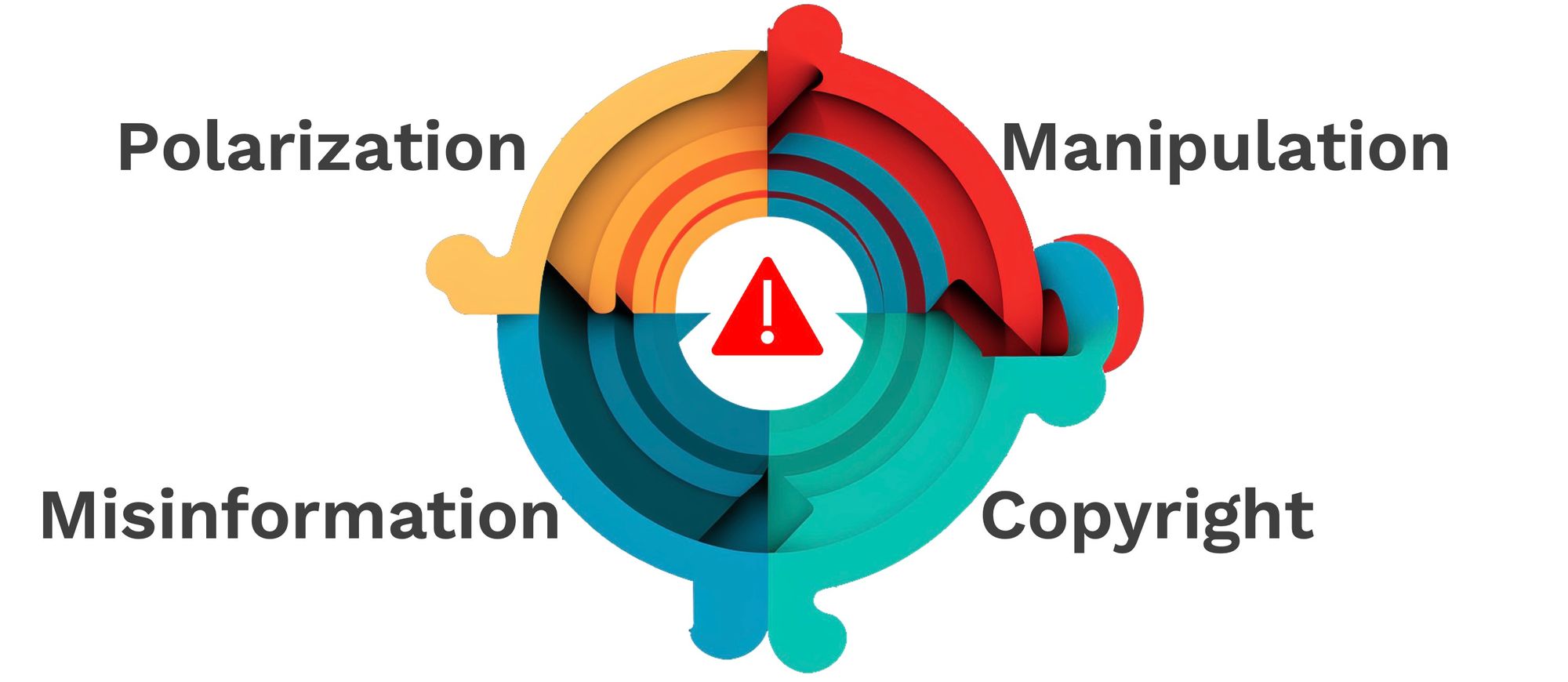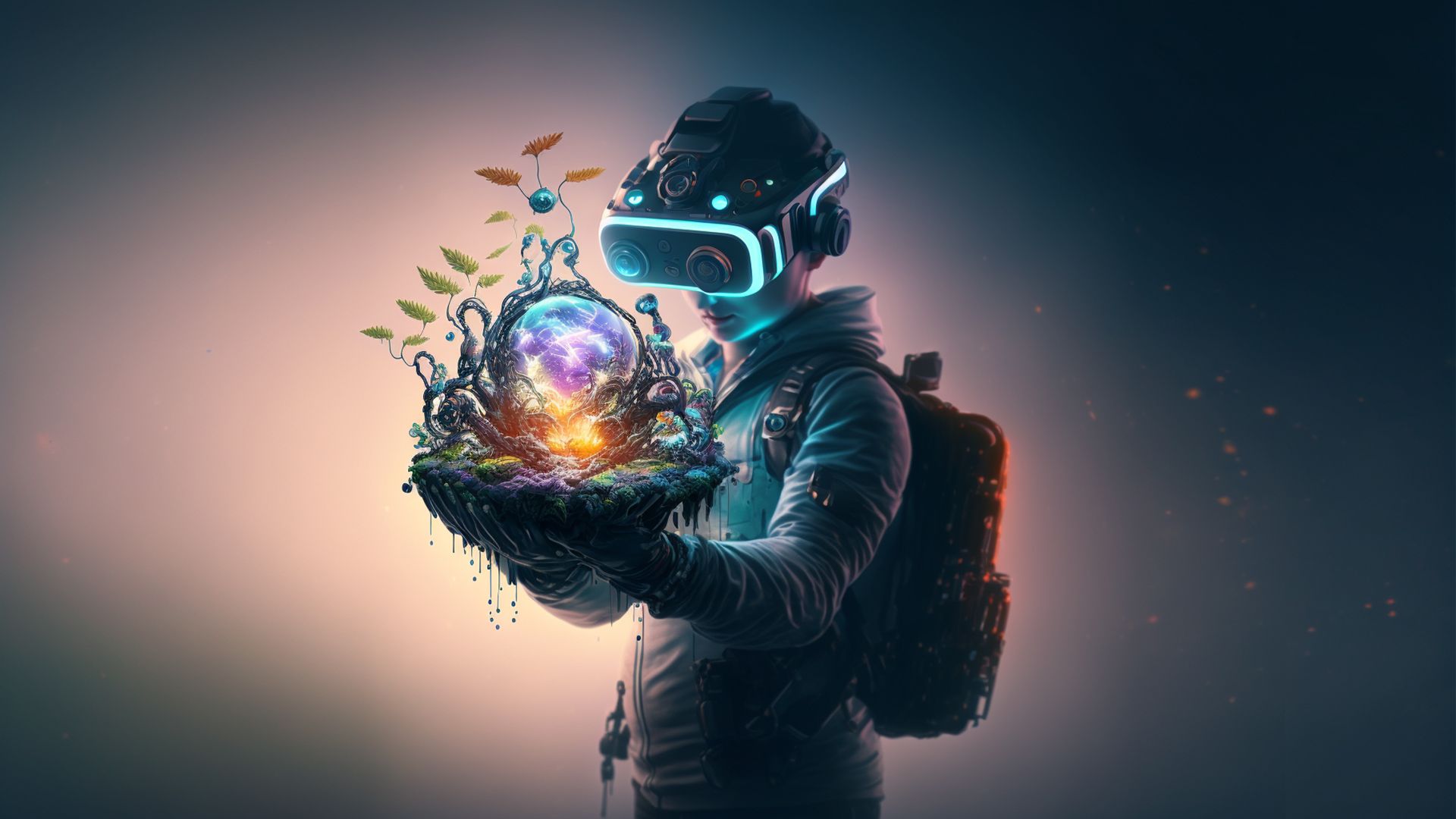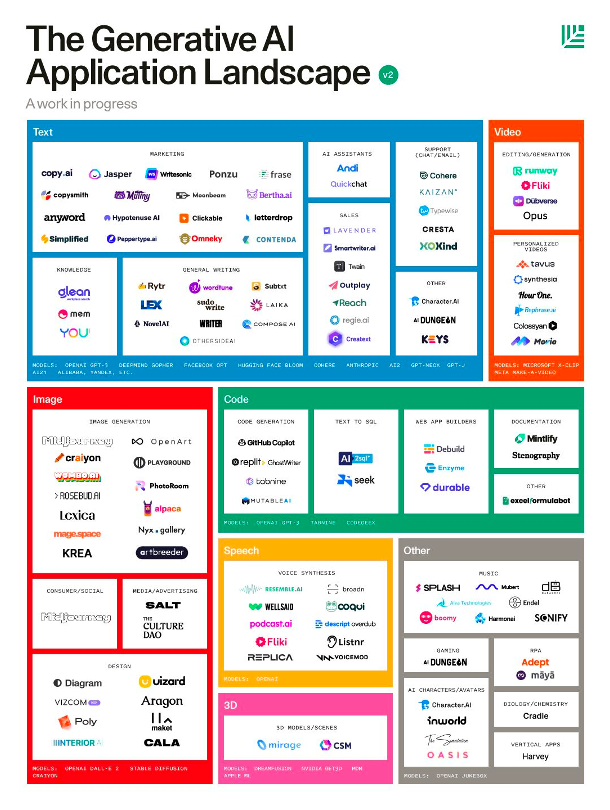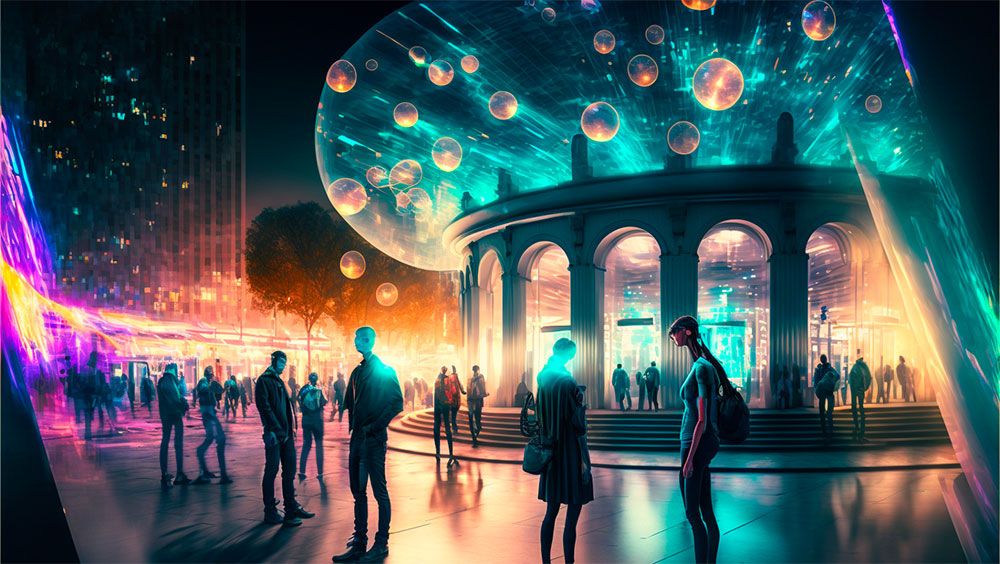Unleashing the Generative AI Genie: A Brave New Metaverse or a Nightmare Scenario?

In my role as a strategic futurist and innovation keynote speaker, it is exciting to see the rapid advancement of generative AI and its potential to shape the metaverse. Earlier today, I delivered the main keynote at TMRW Dubai on the convergence of two major trends happening today: generative AI and the metaverse.
The metaverse is the next iteration of the internet: a version of the internet that supports immersive, interactive, and persistent online digital experiences. The metaverse is not a single place, let alone one specific virtual world, as portrayed by Ready Player One. The metaverse will be the convergence of the physical and the digital world where all of our data—such as identity, personality, reputation, and assets, and also the entire history, feeling, and/or emotion of any (virtual or physical) place, organisation or thing—can be interacted with, controlled, and experienced in completely novel ways so that people, and things, can create new, magical, experiences, interactions, and environments.
We will move from a 2D internet that requires an active decision to go on the internet to a 3D internet where we are in the internet. The convergence of the digital and the physical worlds will enable yet-to-be-developed applications, and the metaverse just got brought forward a few years due to the generative AI.
The emergence of generative AI has given us the ability to create artworks that are indistinguishable from those created by humans, and sometimes even better some would argue. This technology will soon allow us to create entire digital worlds just with a simple prompt, allowing for hyper-personalised, interactive, dynamic and immersive digital experiences that will drive engagement and joy across the metaverse.
In this article, we will explore the convergence of generative AI and the metaverse and find out whether it will be a brave new world metaverse or a nightmare scenario.
What is Generative AI - update?
Since my last update, there have been significant advancements in this technology, particularly in the area of 3D generative AI.
Generative AI is a subset of AI that is capable of creating new and unique content, from text to images and video, to music and entire virtual worlds. This is done by training the AI model on a large dataset, allowing it to learn patterns and create new content based on those patterns. Generative AI has the potential to disrupt the way we create and experience the metaverse by providing the ability to generate new and dynamic digital environments, characters, and interactions, in real time.
Recent Developments in Generative AI
The launch of ChatGPT, a generative language model developed by OpenAI, marked a major turning point in the field of artificial intelligence. With its ability to generate human-like text responses to questions, ChatGPT quickly gained widespread popularity, attracting over a million users in just five days. This rapid adoption brought generative AI into the mainstream and sparked a wave of innovation and investment in the field. It also started an arms race around generative AI, with Google just announcing their answer in the form of Bard, which is based on their Language Model for Dialogue Applications (or LaMDA for short), and Microsoft just announcing it integrated an updated version of ChatGPT in their Bing search engine and Edge browser.
ChatGPT's impact on the field of artificial intelligence and language processing cannot be overstated. Its ability to generate human-like text responses with high accuracy and coherence is a major breakthrough in the field. Its launch has sparked a wave of innovation and investment in generative AI and has brought the technology into the mainstream. The rapid adoption of ChatGPT by a wide range of industries and applications highlights its potential to transform the way we interact with technology; it achieved 100 million users in just two months!
The future of ChatGPT and generative AI is incredibly exciting. As the technology continues to evolve and improve, it has the potential to revolutionise industries and transform the way we live and work. With its advanced capabilities and limitless potential, ChatGPT is truly a game-changer in the field of artificial intelligence.
Besides ChatGPT, many new products and applications using generative AI have emerged. For example, the Text-to-Music by Google, a tool that uses machine learning algorithms to generate original music based on text input. Another exciting development is Google Deepmind's Sparrow, a cutting-edge chatbot designed to answer users' questions with accuracy and safety in mind. Sparrow reduces the risk of unsafe and inappropriate responses, aiming to be a trusted and reliable source of information. The sophisticated algorithms behind Sparrow try to ensure that users receive the correct answers to their questions, while its advanced safety features protect users from harmful or inappropriate content.
The future of generative AI is looking even brighter with the highly anticipated release of GPT-4, the latest iteration of OpenAI's language model, which promises to take the capabilities of generative AI to new heights.
The AI community is buzzing with excitement about the latest iteration of OpenAI's language model, GPT-4. Building on the success of its predecessors, GPT-4 promises to be the most advanced and capable generative language model to date. Although OpenAI's co-founder Sam Altman stated that users would undoubtedly be disappointed when it is released.
GPT-4 is a state-of-the-art language model that uses machine-learning algorithms to generate human-like text responses to questions and prompts. It is capable of performing a wide range of language tasks, including translation, summarisation, and even creative writing.
What Makes GPT-4 Stand Out?
GPT-4 takes the capabilities of its predecessors to the next level with several key improvements. It has a much larger model size, allowing it to capture better and understand the nuances of language. It has been trained on a vast and diverse corpus of text data, allowing it to generate more accurate and coherent responses.
With that said, the applications of GPT-4 will like be virtually limitless. It can probably be used to generate human-like responses in customer service and support, to create engaging and personalised content, and even to assist in scientific research and discovery - although ChatGPT is very problematic in this area.
Recent developments have demonstrated the ability of generative AI to create full 3D worlds and virtual environments with unprecedented realism. Researchers have been able to train generative AI models on vast datasets of 3D models, textures, and lighting, allowing the AI to generate photorealistic virtual assets and worlds. This has led to the creation of highly immersive and interactive virtual environments, blurring the lines between the physical and the digital world.
Another major breakthrough in generative AI has been in the area of interactive AI-generated content. It has been possible to create generative AI models that can create and adapt virtual environments, characters, and interactions based on user input and interactions. This has led to the creation of highly personalised and interactive virtual experiences, such as virtual shopping and gaming experiences.
In addition, there has been an increase in the use of generative AI in the field of education and training. AI-generated virtual environments and simulations are being used to provide realistic and engaging training experiences for a wide range of industries, including healthcare and transportation. This technology can revolutionise the way we learn and acquire new skills, making it more accessible and efficient.
An example of generative AI in gaming is the creation of procedurally generated virtual worlds. This technology allows for the creation of unique and dynamic virtual environments, characters, and interactions, providing a highly personalised and engaging gaming experience for players. For instance, the game "No Man's Sky" uses a generative AI algorithm to procedurally generate a virtually infinite universe with unique planets, creatures, and even civilisations.
Another example of generative AI in the metaverse is in the field of virtual reality shopping. Companies are using generative AI to create highly realistic and interactive virtual environments, allowing customers to explore and interact with products in a way that was not previously possible. This technology is being used to create virtual showrooms and virtual product personalisation, providing customers with a highly engaging and immersive shopping experience.
Before and After Generative AI
Before the advent of generative AI, creating highly realistic and interactive virtual environments was difficult and time-consuming, as it required the manual creation of digital models, animations, and simulations using gaming engines such as Unity or Unreal Engine 5. This limited the scope and complexity of the environments that could be created and their ability to respond in real time to user interactions. With generative AI, it is now possible to automatically generate highly realistic and interactive virtual environments, reducing the time and effort required to create these environments and increasing their realism and interactivity.
For instance, IKEA uses generative AI to create a fully interactive virtual store where customers can explore and interact with the products and even customise them to their liking. Also, some fashion retailers are using generative AI to create virtual fitting rooms that allow customers to try on clothes virtually without having to physically step inside a store.
What Does Generative AI Mean for Enterprises and Organisations?
The importance of these examples within the metaverse is that they demonstrate how generative AI is being used to create highly immersive and interactive experiences. In the gaming industry, generative AI is being used to create procedurally generated virtual worlds, providing players with a highly personalised and engaging gaming experience. These developments have the potential to revolutionise the games and provide players with new and unique gaming experiences.
Similarly, in the field of virtual reality shopping, generative AI allows customers to explore and interact with products in a way that was not previously possible. This technology can enhance the shopping experience and provide customers with a highly engaging and immersive shopping experience, even when they are not able to physically go to the store. This allows businesses to create new revenue streams by providing virtual product personalisation and virtual reality advertising.
In other words, the use of generative AI in the metaverse is increasingly blurring the lines between reality and the digital world. As a result of this technology, a wide range of industries may be affected, and we may find ourselves interacting, playing, and working in the metaverse in a completely new way.
What Role Will Generative AI Play In the Metaverse?
In the months and years to come, generative AI developments are expected to play a significant role in the development and growth of the metaverse. Generative AI will enable the creation of virtual worlds and digital experiences that are highly personalised and tailored to individual users, providing a more customised and engaging metaverse experience.
An Overview of the Background For Its Development
The latest news in the field of generative AI and the metaverse is the growing interest and investment in this technology by major tech companies. For example, companies like Facebook, Google, and Microsoft have all announced plans to invest in the development of generative AI and the metaverse to create highly realistic and interactive virtual environments, among other developments. In 2022, Facebook spent nearly $14 billion to create its vision of the metaverse, while Microsoft focused more on generative AI with their $10 billion investment in OpenAI while closing down its AltSpace VR world.
Moreover, there has been a recent increase in the number of startups and small companies focusing on developing generative AI technology for the metaverse, with some receiving significant funding from venture capitalists. The impact of ChatGPT and Bard on these startups remains to be seen, however.
Universities and research centres are also investing in this field, exploring the implications of generative AI on the metaverse and developing new AI models for it. Some of them are also partnering with companies to develop new ways of using AI in the metaverse, such as the case of partnership between NVIDIA, Harvard University and the Massachusetts Institute of Technology (MIT).
NVIDIA recently also released a tool to create 3D assets; personalized digital assets created on the fly to populate the metaverse:
As a result, generative AI is expected to play a major role in the development and growth of the metaverse in the months and years to come, with major tech companies and startups investing in the development of this technology.
What Is the Importance Of Partnerships In the Field Of Technology?
These partnerships are significant for the metaverse as it brings together leading technology, research, and academic institutions. NVIDIA's expertise in advanced computing technologies, Harvard's research capabilities, and MIT's innovative approach to problem-solving can contribute to the advancement of the metaverse in several ways.
The partnership between these institutions can accelerate the development of the metaverse by providing access to powerful computing systems and leading-edge research. The collaboration can lead to innovations in areas such as virtual reality, computer graphics, and artificial intelligence, which are critical components of the metaverse. It can help drive new scientific discoveries and applications that can benefit the metaverse and society. The pooling of resources, knowledge, and expertise between these institutions can lead to new insights and solutions that can help shape the future of the metaverse.
In essence, this partnership represents the type of collaboration that is desperately needed globally to harness technology for the betterment of society. By bringing together leaders in technology, research, and academia, this partnership— and all partnerships happening in the near future— has the potential to drive innovation and progress in ways that will benefit us all. By pooling resources, knowledge, and expertise, this partnership can help us to overcome some of the most pressing challenges facing our society and pave the way for a brighter, more technologically advanced future. The importance of this type of collaboration cannot be overstated, and it serves as a model for how we can use technology to our advantage and move forward as a society.
Generative AI and the Metaverse
Generated AI is also expected to contribute to the metaverse by enabling the creation of virtual avatars and digital characters that are highly realistic and expressive. This will allow for more natural and realistic interactions between users within the metaverse and will enable the development of virtual social spaces that are more immersive and reciprocal. The metaverse driven by generative AI will enable you to be who you want, regardless of physical restraints or considerations. It will enable individuals to explore their identity in ways never possible before and create new funky avatars on the fly with a simple prompt.
Generative AI can also contribute to the metaverse by allowing for the creation of virtual economies and digital marketplaces. By using generative AI to create virtual goods and services, businesses will be able to create new revenue streams within the metaverse, which could potentially be sold using NFTs. However, creating these digital assets using generative AI is, not yet, an expertise that everyone has.
PromptBase, a platform that offers a marketplace for buying and selling high-quality generative AI prompts, aims to change that. The prompts are designed to produce the best results and save users money on API costs. The platform provides a convenient and cost-effective solution for businesses and organisations seeking to utilise generative AI's power in their operations. With a wide selection of prompts, users can easily find the right prompts to suit their needs and achieve their desired results.
As mentioned before, another interesting area where generative AI is expected to contribute to the metaverse is in the field of education and training. The use of generative AI in virtual education and training opens up new opportunities for learners to experience hands-on training in a safe, engaging, and realistic virtual environment. By eliminating the barriers of time, location, and cost, this technology makes it easier for people to access quality education and training opportunities, regardless of where they are in the world.
With the help of generative AI, educators and trainers will be able to create more engaging and effective virtual training programs. This technology can be used to create virtual classrooms, virtual labs, and virtual simulations tailored to the specific needs of students and trainees and adapted on the fly based on the discussion between teacher and students. Another great way to reinvent education!
Generative AI can enable the creation of virtual assistants, chatbots, and digital guides that can provide users with personalised recommendations and assistance within the metaverse. These virtual assistants can be used to help users navigate the metaverse, find specific content or services, and interact with other users. This can enhance the overall metaverse experience for users and make it more intuitive and accessible. In a similar way, artificially intelligent non-playing characters (AI NPCs) can have very realistic dialogues with the players or students, adding a new dimension to the experience.
Also, Generative AI is expected to play a key role in the field of entertainment in the metaverse. For example, AI models can be used to create virtual performers and entertainers, such as virtual bands, virtual DJs, and virtual comedians, that create synthetic media on the fly. This technology can be used to create virtual events and experiences that are highly personalised and engaging.
Lastly, Generative AI can also be used to create virtual art and digital sculptures; this can open a new way to express creativity and art within the metaverse and could also be a source of revenue for artists and creators. These virtual art pieces can be positioned not only in the virtual world but also in the real world as digital experiences through the use of augmented reality (AR).
AR technology enables digital art pieces to be overlaid on the physical world, creating a unique and interactive experience for the viewer. However, creating AR content is hard, as it needs to take into account that the content can be viewed from different perspectives with different lighting and backgrounds. Generative AI can make this process a lot easier. This opens up new opportunities for artists and creators to showcase their work in both virtual and physical environments, providing a wider reach and audience for their art.
With the advent of generative AI, developers will be able to add whole new classes of goods and services to their virtual world creations. As this technology continues to grow at an exponential rate, there is no telling the direction it will take our metaverse. But one thing is certain,enerative AI has the potential to impact our society in a number of positive ways.
How Should We Use This Technology
It is important to highlight that generative AI is a powerful tool with the potential to revolutionise the metaverse, but it is also important to use it with care. The use of generative AI in the metaverse should be guided by a set of ethical principles that ensure that the technology is used in a way that is safe, fair, and respects the rights of users.
One of the key ethical considerations when using generative AI in the metaverse is the issue of data privacy and security. As the metaverse becomes more data-driven, it is important to ensure that user data is collected, stored, and used in a way that respects user privacy and is compliant with relevant laws and regulations. Ideally, the data, digital assets and identity are owned and controlled by the user, not Big Tech. This may include implementing robust data protection and security measures, such as encryption and anonymisation, to ensure that user data is protected from unauthorised access or misuse. After all, every prompt you provide to a generative AI is fully accessible to the company building it.
Another important ethical consideration when using generative AI in the metaverse is the issue of bias and fairness. As generative AI models are trained on large data sets, they may inadvertently learn and perpetuate biases that are present in the data. It is important to ensure that generative AI models are trained on diverse and representative data sets and that they are tested and evaluated for bias before they are deployed in the metaverse.
Using generative AI in the metaverse should also be guided by principles of transparency and explainability. This means that users should be able to understand how the AI systems are making decisions and be able to access the data that is being used to train the models.
Finally, the use of generative AI in the metaverse should be guided by the principle of inclusivity. This means that the technology should be designed and developed to be accessible to all users, regardless of their background or abilities.
Generative AI in the Metaverse: Limitations and Dangers
As with any powerful technology, there are potential limitations and dangers of generative AI in the metaverse that must be considered. One limitation is the issue of scalability. Generative AI models require large amounts of data and computational resources to train and run. As the metaverse continues to expand and more users and applications come online, it may become increasingly difficult to scale generative AI models to meet the demands of the platform.

When it comes to creating content with synthetic data, certain challenges arise. For example, the data used to create a text may not accurately reflect real-world scenarios. They may, therefore, not be representative of this diversity present within the real world.
While synthetic data offers a promising solution to the scalability issue in generative AI in the metaverse, its use must be carefully considered and approached with caution. It is essential to ensure that synthetic data accurately reflects real-world scenarios and that models are trained on diverse data to avoid over-fitting and biases.
Another limitation is the issue of interpretability and explainability. Generative AI models, especially deep learning models, can be complex and opaque, making it difficult for users to understand how they are making decisions. This can be a problem in the metaverse, where users may want to understand how the AI systems are impacting their experience or how a decision was made that affects them.
One of the dangers of generative AI in the metaverse is the potential for misuse or abuse of the technology. For example, generative AI models could be used to create deepfake avatars that impersonate real users or generate fake content designed to manipulate or deceive users. This could have serious consequences for the credibility and trust of the metaverse, as well as for the rights and safety of users.
The increasing personalisation offered by generative AI in the metaverse can lead to the creation of echo chambers where users are only exposed to views and information that align with their own. This can further exacerbate existing political and ideological divisions, leading to greater polarisation. Additionally, the creation of fake news and propaganda through the use of generative AI can have a detrimental impact on the spread of accurate information, leading to widespread misinformation.
The issue of copyright also becomes increasingly complex with generative AI, as it becomes more difficult to determine the original creator of digital content. This can result in disputes over ownership and control of virtual assets and intellectual property, leading to legal and ethical questions that must be addressed. In order to mitigate these risks, it is crucial that ethical principles, transparency, and accountability guide the development and use of generative AI in the metaverse.
Addressing these challenges will require a collaborative effort from governments, industry, civil society, and technical experts. By working together, we can develop responsible governance models for the metaverse and generative AI, ensuring that this technology is used for the benefit of all.
Metaverse Components Disrupted by Generative AI

The metaverse requires a lot of digital content, including text and code, audio, images, assets, and worlds. To bring the metaverse to life, these various elements must be developed and come together to create a seamless and engaging user experience. That means creating billions or trillions of assets, which would be impossible to do manually. That's where generative AI comes into play.
These components are each being disrupted by generative AI in different ways. One of the most notable areas of disruption is in audio, specifically music and voice. Generative AI models are now able to create entirely new music tracks and even entire albums, with examples such as Amper Music and Google's MusicLM. Similarly, AI-generated voice technology has advanced enough to create realistic synthetic speech and voice actors that can be used in audio dramas, video games, and other interactive experiences.
Another area of disruption is in text, specifically in the generation of written content such as news articles, fiction, and even poetry. Generative AI models, such as ChatGPT's ability to generate human-like text, make it one of the most important tools right now out there for creating realistic and engaging experiences within the metaverse. That is, until new tools arrive on the scene, most likely later this year.
Already, ChatGPT can be used to generate dialogue for Non-Player Characters (NPCs) in a game, allowing for more realistic and engaging interactions with virtual characters. It can also generate written content for virtual worlds, such as descriptions of locations, objects, and events, which can help create a more immersive experience for users.
ChatGPT's ability to understand and respond to natural language inputs also can be utilised to create virtual assistants or chatbots that can interact with users in the metaverse, providing information and assistance, and could even help with the navigation of the metaverse.
Images are another area where generative AI is making an impact. Generative AI models can be used to create entirely new images and even videos, such as creating realistic 3D models of buildings, cars, and other objects or generating realistic images of people that do not exist. This technology has already begun to be used in the film and gaming industries and in creating virtual and augmented reality experiences.
Stable Diffusion and Midjourney are two important platforms in the field of generative AI, particularly in the context of the metaverse.
Stable Diffusion allows the creation of photorealistic images from text input. It is a latent text-to-image diffusion model that allows users to generate incredible imagery with great ease and speed. The goal of Stable Diffusion is to provide a tool that empowers billions of people to create stunning art within seconds and cultivate their creative freedom.
Midjourney is an AI-powered image generator that creates new and original images. It uses various machine learning algorithms and deep neural networks to analyse existing images and then generate new images based on the features it recognises. The result is a new and unique image that captures the essence of the input while still being different and original. Midjourney provides a quick and efficient way for designers, artists, and content creators to generate new images without having to spend hours or days on manual design work. I have been using Midjourney for some time now; it is an amazing tool. In case you do not know what prompts, styles and parameters to use, check out this extensive library.
Both of these platforms open up new possibilities for visual expression and creativity and are set to play a significant role in the future of the creative industries.
Lastly, virtual worlds are also being disrupted by generative AI. AI-generated virtual worlds are already being used to create entirely new experiences that can be used for education, entertainment, and other purposes. For example, AI-generated virtual worlds can be used to simulate realistic environments, such as cities or natural landscapes, that can be used for training, research, or even as a form of therapy. Additionally, AI-generated virtual worlds can also be used to produce entirely new and fantastical environments that are beyond the scope of what is possible in the real world, for instance, OpenAI's Point-E — known as the successor of Dall-E 2 —will be launched to generate 3D worlds with AI.
Undoubtedly, generative AI is disrupting a wide range of components that make up the metaverse, such as audio, text, images, assets, and virtual worlds. Real-world examples of this disruption can be seen in the creation of AI-generated music, synthetic speech, news articles, 3D models, digital fashion, avatars, and virtual worlds. As technology continues to evolve and improve, we may see even more ways in which generative AI will shape the metaverse of the future.
Exploring the Rapidly Growing Market for Generative AI in the Metaverse
As the demand for more immersive and interactive virtual experiences grows, the market for generative AI in the metaverse is expected to experience significant growth. Generative AI has the potential to streamline the content creation process and provide fast, efficient, and cost-effective solutions for the creation of digital content. Whether creating unique and customised avatars, designing digital fashion, or generating 3D models of buildings and other structures, generative AI has a key role to play in the development of the metaverse.
The convergence of generative AI and the metaverse is a rapidly growing market that holds great potential for innovation and growth. As the demand for immersive virtual experiences continues to grow, the role of generative AI in the metaverse will likely continue to expand, driving the growth of the metaverse and shaping the future of immersive computing.
The growth of generative AI in the metaverse is likely to significantly impact enterprises and organisations moving forward. Here are a few ways in which this will play out:
Increased Efficiency
By automating parts of the content creation process, generative AI will increase the speed and efficiency of digital content creation, allowing organisations to bring their ideas to life faster and more effectively.
Cost Savings
By reducing the need for manual labour, generative AI will lower the cost of digital content creation, making it more accessible to organisations of all sizes.
Improved User Experience
With the ability to create unique and customised avatars and other digital content, organisations will be able to enhance the user experience and foster greater engagement with their target audience.
Enhanced Virtual Events
The ability to create realistic and engaging virtual environments will allow organisations to host virtual events, training sessions, and conferences in a more interactive and immersive way from anywhere in the world.
New Business Opportunities
Organisations can create virtual storefronts, sell virtual real estate, and offer digital fashion items for purchase. The metaverse will also provide new opportunities for gaming companies to create immersive and engaging gaming experiences. In addition, the convergence of generative AI and the metaverse will enable organisations to understand their customers better and collect and analyse data from virtual interactions. This data can then be used to improve products and services and create more personalised and engaging user experiences.
Startups Working in Generative AI in the Metaverse
Many startups are working in the field of generative AI in the metaverse, each focusing on a different aspect of the technology. The generative AI landscape is vast and growing rapidly, see the below infographic, but here are some notable examples:

DeepMotion
A company that develops AI-powered virtual characters and avatars for use in the metaverse, including digital twins and non-playing characters.
DeepMotion is a company based in the United States that develops AI-powered virtual characters and avatars for use in the metaverse, including digital twins and non-playing characters. The company's main service is the development of AI-powered virtual characters, which can be used in a variety of applications, including video games, film, virtual and augmented reality experiences, and digital twins for industries such as healthcare, retail and education.
By using advanced machine learning algorithms, the company can create virtual characters that can move, behave, and express emotions in a highly realistic and believable manner while reducing the time and resources required to create them.
The company has partnerships with game studios and animation studios, as well as other companies in the virtual and augmented reality space, to provide them with their virtual character services. DeepMotion is also working on research projects in partnership with universities and other research institutions to explore new possibilities in the field of AI and virtual characters.
Synthetix
Synthetix is a startup founded in 2017 in Sydney, Australia, and is a blockchain-based platform for creating, trading and using synthetic assets. Synthetix is an open-source, decentralised protocol built on Ethereum which aims to provide a decentralised solution for synthetic assets, it enables the creation of assets that track the value of real-world assets, and it allows for the creation of assets that do not currently exist on any other platform. It also allows for the creation of synthetic assets that can be used in a variety of applications, including lending, trading, and stablecoins.
One of the key innovations of Synthetix is that it allows for the creation of synthetic assets that track the value of real-world assets such as currencies, commodities, and stocks. This enables users to gain exposure to these assets without actually owning them. Also, since it is an open-source project, it allows many developers to contribute to the project and help improve it.
Voiceflow
Voiceflow uses generative AI to create realistic, 3D virtual environments for use in audio and voice-based applications, including voice assistants, chatbots, and voice-enabled games.
Founded in Toronto, Canada, Voiceflow's main service is the creation of voice-based experiences that allow users to interact with virtual environments through voice commands. Using a drag-and-drop interface, the company's platform allows developers to easily create and edit voice-based experiences, including voice assistants, chatbots, and voice-enabled games.
The key innovation of Voiceflow is its use of generative AI technology to create highly realistic and engaging virtual environments for voice-based applications. The company's AI algorithms can analyse real-world environments and create digital models that are highly accurate and true to the original. This allows for creating virtual environments that are almost indistinguishable from their real-world counterparts, making them ideal for audio and voice-based applications.
VALL-E
Microsoft is developing an AI system called VALL-E that is capable of creating a voice clone from just a 3-second audio clip. This AI system is trained to replicate the speaking style and tone of a person's voice based on a short recording and can then generate new speech in the same voice. With this technology, it is possible to create digital versions of someone's voice that can be used for various applications, such as voice assistants, voice-based games, and other voice-driven experiences.
InWorld.ai
Inworld.ai is a startup that provides a platform for adding advanced NPC (Non-Playable Character) behaviour and unscripted dialogue to games and real-time media. By using artificial intelligence, Inworld's platform creates more realistic and believable characters in these digital worlds.
Inworld's platform allows developers to create character personalities by using text-to-character prompts and then integrating these characters into experiences through Inworld's SDKs. This level of customisation and control makes it possible to create immersive and engaging experiences that feel truly alive and believable.
The use of AI in this way is a major step forward in the gaming and immersive media industries. By bringing advanced NPC behaviour and unscripted dialogue to games and other real-time media, Inworld's platform allows for a level of realism and immersion that was previously impossible. This opens up new possibilities for game developers and content creators to create more captivating and engaging experiences for their audiences.
Why These Generative AI Startups Matter in the Current Landscape
Each of these companies are pushing the boundaries of what is possible with generative AI in the metaverse, and their work is likely to have a crucial impact on the future of the industry. Of course, it is only a small selection, as there are many more as the above generative AI landscape shows.
I believe we will see a rise in the number of startups focused on virtual worlds, augmented reality, virtual reality, mixed reality, and other types of immersive computing enabled by generative AI. Generative products and services will no doubt appeal to a wide segment of the population. As with any revolutionary product, though, there will naturally be roadblocks as users and technology adapt.
What Role Will Generative AI Play in the Next Decade?

In the next decade, there will likely be a significant increase in the use of generative AI to create highly realistic and personalised virtual environments. These environments will be generated on the fly, providing a truly immersive and engaging experience for users.
As the use of generative AI continues to grow in the metaverse, new job opportunities are emerging to support this convergence. One such role is the Prompt Engineer, whose main responsibility is to design and implement effective language prompts that can be used to generate content in virtual worlds. Scale.ai recently published the first job post for a prompt engineer with a salary of around 250k - 335k.
The role of the Prompt Engineer involves understanding the underlying generative AI models and algorithms and using this knowledge to create language prompts that are intuitive and effective. They work closely with AI engineers, artists, and other creative professionals to ensure that the generated content is accurate, relevant, and engaging.
Also, the Prompt Engineer must have a deep understanding of natural language processing, machine learning, and computer graphics, as well as the ability to create compelling storylines and narratives. This is a glimpse of how the employment landscape will soon be affected by the rapid advances in generative AI and the developments occurring daily in the metaverse.
The convergence of generative AI and the metaverse has the potential to bring about tremendous benefits and opportunities for society, including the creation of more immersive and interactive virtual experiences, the development of new forms of communication, and the ability to generate vast amounts of digital content in real-time. However, as with any new technology, some potential risks and challenges must be carefully considered and addressed.
One of the most important things to understand is that technology is neutral, meaning that it has no inherent good or bad qualities. Instead, the impact of technology is shaped by how it is designed, developed, and used. This means that the convergence of generative AI and the metaverse has the potential to be either positive or negative, depending on the choices we make.
For example, generative AI has the potential to revolutionise the way we create digital content, making it easier and faster to produce high-quality virtual experiences. At the same time, however, there are concerns about the potential for generative AI to perpetuate biases and perpetuate harmful content, such as hate speech or fake news.
It is up to us, as individuals, organisations, and society as a whole, to determine the ethical and responsible ways to use this technology, to ensure that its benefits are maximised and its risks are minimised. This will require careful consideration of the potential consequences of generative AI and the metaverse, as well as the development of responsible and ethical standards for their use. By doing so, we can help to ensure that the convergence of generative AI and the metaverse contributes to a better and more sustainable future for all.
Final Thoughts
I believe that generative AI will play a defining role in the metaverse in the coming decade. As the metaverse becomes a reality, generative AI is uniquely positioned to shape the way we experience it.
Firstly, generative AI's ability to analyse real-world objects and environments and create highly accurate digital models will be critical in creating hyper-realistic virtual environments in the metaverse. These virtual environments will be almost indistinguishable from the real world, providing users with a truly immersive and engaging experience.
Secondly, generative AI's ability to create personalised virtual environments tailored to individual users will be a game-changer for the metaverse. Customised experiences will be more engaging for users and marketers will be able to target ads and promote their products more accurately.
Finally, generative AI will also play a vital role in creating virtual characters that are believable and can interact with users naturally. This will open up new possibilities for entertainment, education, and other applications in the metaverse.
That being said, generative AI will be a defining technology in the metaverse in the next decade. Companies and organisations that understand the power of the metaverse, virtual reality, and AI will be at an advantage in creating a new kind of internet.
It is exciting to think about the potential that this technology will bring to the metaverse and other industries. The future is bright, and I cannot wait to see how generative AI will shape it.





